The Middle East & Africa (MEA) data-storage market is projected to grow from USD 8 billion in 2025 to USD 27.2 billion by 2035 at a 13 % CAGR. Future Market Insights links the growth directly to multi-billion-dollar infrastructure pledges announced at events such as LEAP 2025, where Equinix confirmed a USD 1 billion, 100 MW Riyadh facility.
Amazon Web Services unveiled a USD 5.3 billion Saudi cloud region slated for 2026. At the same summit, DataVolt signed a USD 5 billion deal to develop a 1.5 GW net-zero campus in NEOM’s Oxagon, highlighting how green-finance covenants are reshaping power and cooling choices.
Edge expansion is equally pivotal--IFC’s USD 100 million financing for Raxio Group will seed carrier-neutral sites from Ethiopia to Angola, bringing latency-sensitive fintech and gaming workloads back from European hubs. Flash arrays and 25-100 GbE fabrics are gaining share as 5G, IoT, and AI analytics demand sub-millisecond access times, while regulators from Saudi Arabia to South Africa tighten audits on data residency and resilience, rewarding providers that pair ISO 27001 controls with sovereign-cloud zones.
Summing up the opportunity, Judith Gardiner, vice-president for emerging markets at Equinix, told journalists at LEAP 2025, “The new Saudi facility will serve our hyperscale and retail customers in-kingdom and attract international clients to the Middle East,”. This strategy would transform the region into a globally integrated data-supply node.
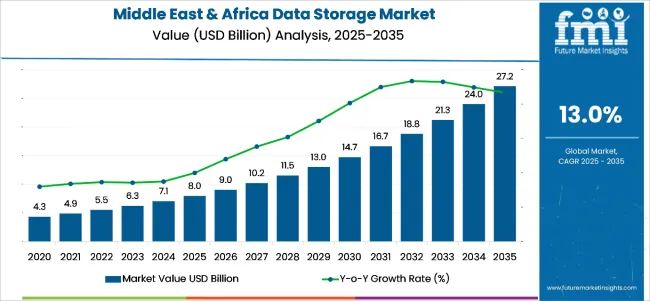
| Attributes | Description |
|---|---|
| Historical Size, 2024 | USD 7,161.4 million |
| Estimated Size, 2025 | USD 8 billion |
| Projected Size, 2035 | USD 27.2 billion |
| Value-based CAGR (2025 to 2035) | 13% CAGR |
Microsoft’s additional USD 300 million AI-cloud investment in South Africa, unveiled in March 2025, and Oracle’s pledge to add eight new cloud regions-including expanded capacity in Johannesburg-announced in January 2025, sharpen hyperscaler momentum. Abu-Dhabi-based G42 Cloud’s 2023 alliance with VAST Data is now rolling out ultra-dense, all-flash object stores that slash power per terabyte by 60 %.
Future Market Insights forecasts MEA enterprise-storage deployments will triple by 2030, demanding roughly 8 GW of renewable-backed power to meet AI, IoT, and sovereign-compliance workloads by enterprises. Such investments attracts significant opportunities for market players in data storage.
Digitalization in the Middle East and Africa is accelerating due to proactive government initiatives aimed at economic diversification, service modernization, and global competitiveness. National strategies like Saudi Arabia’s Vision 2030, UAE’s Smart Government, and Kenya’s Digital Economy Blueprint are channeling substantial public and private investment into cloud infrastructure, smart cities, and digital services. Governments are promoting data sovereignty through localized data centers, cloud-first mandates, and partnerships with global technology providers.
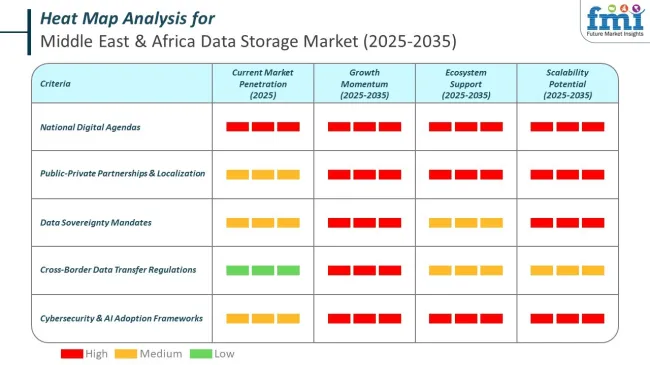
Governments in the Middle East & Africa (MEA) have introduced several data governance and protection frameworks that directly influence the regional data storage market. These regulations are designed to ensure data sovereignty, improve cybersecurity, and support the localization of cloud infrastructure:
This below table presents the expected CAGR for the Middle East & Africa data storage market over several semi-annual periods spanning from 2024 to 2034. In the first half (H1) of the year from 2024 to 2034, the industry is predicted to surge at a CAGR of 13.2%, followed by a slightly lower growth rate of 12.9% in the second half (H2) of the same year.
| Particular | Value CAGR |
|---|---|
| H1, 2024 | 13.2% (2024 to 2034) |
| H2, 2024 | 12.9% (2024 to 2034) |
| H1, 2025 | 13.6% (2025 to 2035) |
| H2, 2025 | 12.7% (2025 to 2035) |
Moving into the subsequent period, from H1 2025 to H2 2035, the CAGR is projected to hold at 13.6% in the first half from 2025 to 2035 and remain considerably decrease at 12.7% in the second half 2025 to 2035. In the first half (H1) 2025 to 2035 the market witnessed an increase of 40 BPS while in the second half (H2) 2025 to 2035 the market witnessed a decrease of 20 BPS.
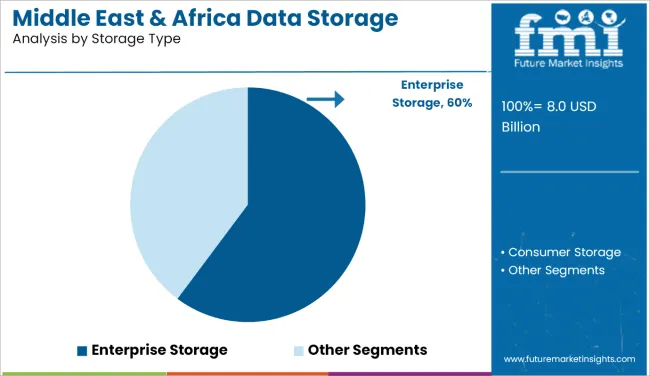
In 2025, the enterprise storage segment is projected to hold a dominant position in the Middle East & Africa (MEA) data storage market, accounting for approximately 60.2% of the market share in 2025. This growth is driven by the region's ongoing digital transformation initiatives, including the adoption of cloud computing and big data analytics. Countries like Saudi Arabia and the UAE have implemented stringent data control and safety regulations, further increasing the demand for local enterprise storage solutions.
Major technology companies such as Dell, Hewlett Packard Enterprise (HPE), and Huawei are investing significantly in the region, offering advanced storage options like all-flash arrays and hybrid storage systems tailored to meet the needs of MEA businesses.
The expansion of data centers to support cloud services and AI-based applications also contributes to the market's growth. NetApp, a key player in the market, announced plans in 2023 to expand its presence in the Middle East, reflecting the anticipated continued focus on enterprise storage as businesses embrace digitalization and new regulations come into effect.
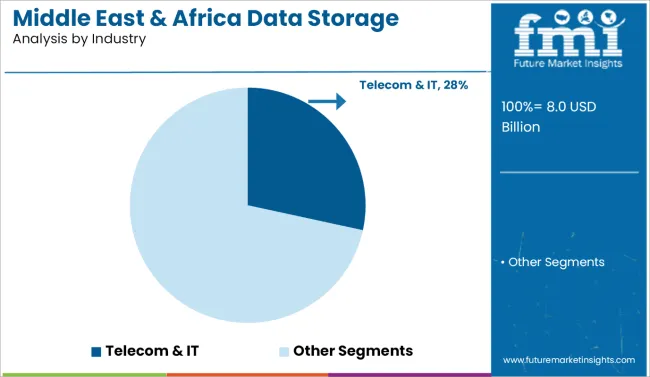
The telecom and IT industry segment is expected to account for approximately 28.4% of the MEA data storage market in 2025. The rollout of 5G networks in Gulf Cooperation Council (GCC) countries and the rise of smart city projects have significantly increased the need for scalable and reliable storage solutions. Telecom companies are investing heavily in cutting-edge storage systems to manage the surge in data traffic and support cloud services essential for modern operations.
According to Future Market Insights, IT spending in the GCC countries exceeded USD 90 billion in 2023, underscoring the commitment of governments and vendors to digital infrastructure development. Leading telecom operators like Saudi Telecom Company and Etisalat are enhancing their storage capabilities to accommodate the growing data demands and to facilitate the delivery of advanced services.
The market's growth has a strong connection to several main factors. These include the rise in cloud service, smart city progress, and 5G network rollout. These steps forward are causing a big increase in data creation. This, in turn, is boosting the need for advanced and flexible data storage solutions.
In the UAE, the government's focus on smart city projects, along with more individual using digital devices, is encouraging investments into cloud storage solutions. Big tech firms such as Amazon Web Services (AWS) and Oracle have grown their data storage services in the region.
AWS, for example, set up a new infrastructure region in Cape Town making cloud services easier to access across Africa. In the same way, Oracle's new cloud region in Abu Dhabi aims to meet the increasing need for safe scalable data storage in the GCC.
In Israel, the government's Nimbus Project works with big tech companies like Google and AWS to change how the public sector stores data by moving key services to the cloud. This plan is part of a bigger push to update IT systems and improve data security across the country.
South Africa is also emerging in the MEA data storage scene, with big investments coming in from both government and business to boost data center abilities. The USA International Development Finance Corporation's USD 300 million investment in Africa Data Centres shows how important this region is becoming as a spot for storing and crunching data.
These changes highlight how IT sector growth has a big impact on the need for cutting-edge data storage in the Middle East and Africa. This makes the region a key player in the worldwide data storage market.
As companies in MEA undergo digital shift, they need strong ways to protect data. This has led to more individuals as well as industries wanting safe methods to store data.
A key example of this trend is how cloud-based data storage services with top-notch security features have caught on. Take the financial services industry, which depends heavily on digital banking. It's seen a notable increase in the use of encrypted cloud storage to protect sensitive customer data.
This industry alone makes up a big chunk of the region's cybersecurity spending, with banks in the UAE and Saudi Arabia spearheading efforts to set up secure data environments.
In the similar manner, government plans like Saudi Arabia's Vision 2030 and the UAE's National Cybersecurity Strategy are pushing companies to adopt strict data protection measures. These plans stress how important cybersecurity is for national infrastructure leading to more investment in secure data storage solutions that can face complex cyber threats.
The need for data storage and cloud services is on the rise driven by smart cities, IoT, and 5G tech. This growth has made it clear that the region lacks in having enough skilled workers to manage and maintain these complex systems.
This lack of talent has sparked new ideas to close the skills gap. Microsoft, for example, has stepped up in the region. They started the Microsoft Cloud Society, which has trained more than 200,000 local members in cloud and AI tech.
Also, governments are tackling the worker shortage head-on. One such effort is the African Development Bank's plan to train 50 million young people and create 25 million jobs. These programs aim to give youngsters the digital skills they need.
The lack of skilled workers has pushed companies to invest in automation and AI-powered management tools for data centers. Businesses are now using these technologies to make up for the shortage of human skilled labor, with tools like predictive maintenance and automated monitoring becoming more widespread.
This change not only helps in reducing the immediate effects of the skills gap but also boosts the productivity and dependability of data center operations throughout the region.
The financial and telecom sectors are going through rapid digital transformation. This is creating need for enhanced data storage, as these industries create more and more of it.
Banks and other money-related businesses now use online banking, phone payments, and new technology tools more often. This means they need strong systems to store all the data from transactions. Take the banking industry, for instance.
They're investing heavily in cloud storage and hyper-converged infrastructures that provide scalability, security, and real-time data processing capabilities. Also complex regulations about keeping data safe are making banks step up their game when it comes to storing data. This leads to more demand for smart storage solutions in the region.
In the same way, the telecom industry is growing fast as companies roll out 5G networks Internet of Things (IoT) tech, and expand mobile broadband. These changes mean there is high need of big data storage systems that can handle lots of data and offer reliable quick services.
Telecom firms in the MEA area are putting money into data centers and cloud services to back up their expanding systems. Both global and local players are making big investments in this field.
For example, Amazon Web Services (AWS) and Oracle have grown their data center footprint in the area to meet rising demand from telecom companies and banks. Also, laying new undersea cables and building smart city projects are driving up the need for cutting-edge data storage options. This makes this sector a crucial engine of growth for the data storage market in MEA.
The Middle East & Africa data storage market went through notable fluctuations and technological advancements in the historical period. The industry was valued at a valuation of USD 4,515.2 million in 2020 to reach USD 7,161.4 million in 2024 with a CAGR of 12.6% from 2020 to 2024.
During pandemic, there was a shift towards more advanced data storage solutions due to rising remote trends in workspace background. GCC Countries, especially The UAE and Saudi Arabia led the region in attracting huge investments owing to their rapid technological advancements.
The market witnessed a considerable growth during the forecasting period between 2025 and 2035. The market reached the valuation of USD 27.2 billion in 2035 from USD 8 billion in 2025 with the CAGR of 13.0%.
With continuously rising advancements in the Middle East, the market expectation is to grow only further. The region is also witnessing high investments in digital infrastructure and rapid adopting of emerging technologies, which will support the market growth.
Tier 1 companies have acquired substantial share of 45% to 50% in the Middle East & Africa data storage market. These companies are driving global expansion with partnerships and large-scale acquisitions. Western Digital, Dell EMC and Microsoft Corporation are top Tier 1 companies that hold the largest market share globally. These vendors are providing wide range of data storage solutions along with personalized demands.
Tier 2 vendors in the global Middle East & Africa data storage market are focusing on enhancing their solutions capabilities. These vendors have the global market reach but lack in competing owing to the gaps in features and capabilities. The vendors in tier 2 bracket includes NetApp Inc., HPE MEA, IBM Corporation among others. These vendors hold around 15% to 20% market share.
Tier 3 companies represent 30% to 35% of share of total Middle East & Africa data storage industry. These vendors focus on the market expansion and providing end-user specific solutions. The vendors in the bracket includes Hitachi Data Systems, Open Text Corporation, Micron Technology among others.
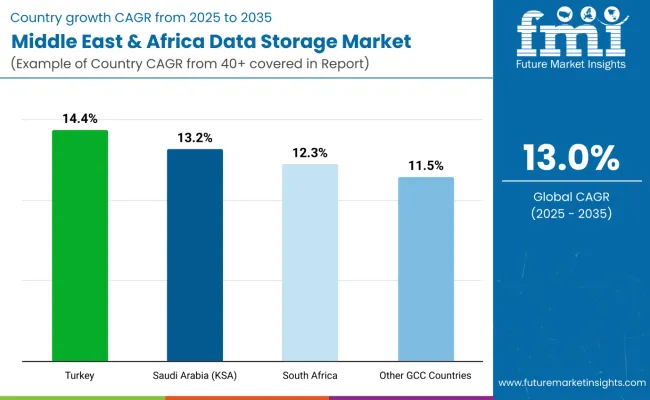
Turkey is witnessing the fastest growth in the data storage market in the Middle East & Africa region, driven by its accelerating digital transformation across both public and private sectors. Additionally, Turkey’s thriving e-commerce sector, along with its expanding fintech and telecom industries, requires vast amounts of real-time data processing and storage The Turkey data storage market is set to grow at 14.4% CAGR during the study period.
Saudi Arabia is rapidly expanding its data storage capabilities as part of its Vision 2030 initiative, which focuses on diversifying the economy and building a digital-first society. The government's strong focus on AI, IoT, and smart infrastructure is creating exponential growth in data generation. The Saudi Arabian data storage market is expected to grow at 13.2% CAGR during the forecast period.
South Africa stands out in the Sub-Saharan region as a key market for data storage growth due to its strong digital foundation. High internet penetration and mobile connectivity rates are generating massive volumes of user data. Global cloud providers and data center operators are investing in the region, further strengthening storage capabilities and creating opportunities for local service providers and technology vendors. The South African data storage market is set to grow at 12.3% CAGR during the study period.
Competition in the Middle East and Africa (MEA) data storage market is fierce. This stems from the quick digital shift and increased cloud services and data technology use. The market moves fast, with high demand for storage solutions that are scalable, secure, and cost-effective.
Key things that shape the industries include the rising adoption of cloud computing and stricter regulations around data sovereignty and safety. As regional firms rely more on digital systems, they want advanced storage tech like SSDs, NVMe, and mixed storage setups. This competitive market also means providers must offer unique answers for different verticals, from telecom to finance and healthcare.
Recent Market Developments
| Report Attributes | Details |
|---|---|
| Estimated Size (2025) | USD 8 billion |
| Projected Size (2035) | USD 27.2 billion |
| CAGR (2025-2035) | 13% |
| Base Year for Estimation | 2024 |
| Historical Period | 2020 to 2024 |
| Forecast Period | 2025 to 2035 |
| Quantitative Units | Revenue in USD million and Volume in petabytes |
| By Storage Type | Consumer Storage, Enterprise Storage |
| By Storage Capacity | Hard Disk Drive (HDD), Memory Card, Optical Disk, Solid State Devices, USB Flash Drives |
| By Enterprise Size | Small Offices (1-9 employees), Small Enterprises (10-99 employees), Medium-sized Enterprises (100-499 employees), Large Enterprises (500-999 employees), Very Large Enterprises (1,000+ employees) |
| By Industry | BFSI, Defense & Aerospace, Education, Government, Healthcare, Telecom & IT, Others |
| By Region | North America, Latin America, East Asia, South Asia & Pacific, Western Europe, Eastern Europe, Middle East and Africa |
| Key Players | STC Solutions, Dell EMC, IBM, Lenovo, Huawei, Hitachi Vantara, Fujitsu, Seagate, Western Digital, Veritas Technologies |
| Additional Attributes | Rapid regional cloud migration, regulatory reforms driving data sovereignty, and growing enterprise demand for hybrid and edge storage architectures are accelerating adoption. Expansion of AI and analytics further fuels demand for scalable solutions. |
| Customization and Pricing | Customization and Pricing Available on Request |
Data storage industry includes Consumer Storage and Enterprise Storage.
The segment is divided into Hard Disk Drive (HDD), Memory Card, Optical Disk, Solid State Devices and USB Flash Drivers.
Small Offices (1-9 employees), Small Enterprises (10-99 employees), Medium-sized Enterprise (100-499 employees), Large Enterprises (500-999 employees) and Very Large Enterprises (1,000+ employees) are segmented in this category.
BFSI, Defense & Aerospace, Education, Government, Healthcare, Telecom & IT and others are segmented in this category.
A regional analysis has been carried out in key countries of North America, Latin America, East Asia, South Asia & Pacific Western Europe, Eastern Europe and Middle East and Africa (MEA).
Table 01: GCC Data Storage Market Value (US$ Mn) Forecast, By Storage Type, 2021–2025
Table 02: GCC Data Storage Market Volume (Thousand Units) Forecast, By Storage Type, 2021–2025
Table 03: GCC Hard Disk Drive (HDD) Data Storage Market Value (US$ Mn) Forecast, By Form Factor, 2021–2025
Table 04: GCC Hard Disk Drive (HDD) Data Storage Market Volume (Thousand Units) Forecast, By Form Factor, 2021–2025
Table 05: GCC Data Storage Market Value (US$ Mn) Forecast, By End User, 2021–2025
Table 06: GCC Data Storage Market Value (US$ Mn) Forecast, By Vertical, 2021–2025
Table 07: GCC Data Storage Market Value (US$ Mn) Forecast, By Region, 2021–2025
Table 08: Levant Data Storage Market Value (US$ Mn) Forecast, By Storage Type, 2021–2025
Table 09: Levant Data Storage Market Volume (Thousand Units) Forecast, By Storage Type, 2021–2025
Table 10: Levant Data Storage Market Value (US$ Mn) Forecast, By Form Factor, 2021–2025
Table 11: Levant Data Storage Market Volume (Thousand Units) Forecast, By Form Factor, 2021–2025
Table 12: Levant Data Storage Market Value (US$ Mn) Forecast, By End User, 2021–2025
Table 13: Levant Data Storage Market Value (US$ Mn) Forecast, By Vertical, 2021–2025
Table 14: Levant Data Storage Market Value (US$ Mn) Forecast, By Region, 2021–2025
Table 15: Africa Data Storage Market Value (US$ Mn) Forecast, By Storage Type, 2021–2025
Table 16: Africa Data Storage Market Volume (Thousand Units) Forecast, By Storage Type, 2021–2025
Table 17: Africa Data Storage Market Value (US$ Mn) Forecast, By Form Factor, 2021–2025
Table 18: Africa Data Storage Market Volume (Thousand Units) Forecast, By Form Factor, 2021–2025
Table 19: Africa Data Storage Market Value (US$ Mn) Forecast, By End User, 2021–2025
Table 20: Africa Data Storage Market Value (US$ Mn) Forecast, By Vertical, 2021–2025
Table 21: Africa Data Storage Market Value (US$ Mn) Forecast, By Region, 2021–2025
Figure 01: MEA Data Storage Market Value (US$ Mn) & Growth (%) Forecast, 2021–2025
Figure 02: MEA Data Storage Market Absolute $ Opportunity, 2022 –2025
Figure 03: GCC Data Storage Market Value Share (%) & BPS Analysis, By Storage Type, 2022 & 2025
Figure 04: GCC Data Storage Market Value Y-o-Y Growth Comparison, By Storage Type, 2022–2025
Figure 05: GCC Data Storage Market Attractiveness Analysis, By Storage Type, 2022–2025
Figure 06: GCC Data Storage Market Value Share (%) & BPS Analysis, By End User, 2022 & 2025
Figure 07: GCC Data Storage Market Value Y-o-Y Growth Comparison, By End User, 2022–2025
Figure 08: GCC Data Storage Market Attractiveness Analysis, By End User, 2022–2025
Figure 09: GCC Data Storage Market Value Share (%) & BPS Analysis, By Region, 2022 & 2025
Figure 10: GCC Data Storage Market Value Y-o-Y Growth Comparison, By Region, 2022–2025
Figure 11: GCC Data Storage Market Attractiveness Analysis, By Region, 2022–2025
Figure 12: Levant Data Storage Market Value Share (%) & BPS Analysis, By Storage Type, 2022 & 2025
Figure 13: Levant Data Storage Market Value Y-o-Y Growth Comparison, By Storage Type, 2022–2025
Figure 14: Levant Data Storage Market Attractiveness Analysis, By Storage Type, 2022–2025
Figure 15: Levant Data Storage Market Value Share (%) & BPS Analysis, By End User, 2022 & 2025
Figure 16: Levant Data Storage Market Value Y-o-Y Growth Comparison, By End User, 2022–2025
Figure 17: Levant Data Storage Market Attractiveness Analysis, By End User, 2022–2025
Figure 18: Levant Data Storage Market Value Share (%) & BPS Analysis, By Region, 2022 & 2025
Figure 19: Levant Data Storage Market Value Y-o-Y Growth Comparison, By Region, 2022–2025
Figure 20: Levant Data Storage Market Attractiveness Analysis, By Region, 2022–2025
Figure 21: Africa Data Storage Market Value Share (%) & BPS Analysis, By Storage Type, 2022 & 2025
Figure 22: Africa Data Storage Market Value Y-o-Y Growth Comparison, By Storage Type, 2022–2025
Figure 23: Africa Data Storage Market Attractiveness Analysis, By Storage Type, 2022–2025
Figure 24: Africa Data Storage Market Value Share (%) & BPS Analysis, By End User, 2022 & 2025
Figure 25: Africa Data Storage Market Value Y-o-Y Growth Comparison, By End User, 2022–2025
Figure 26: Africa Data Storage Market Attractiveness Analysis, By End User, 2022–2025
Figure 27: Africa Data Storage Market Value Share (%) & BPS Analysis, By Region, 2022 & 2025
Figure 28: Africa Data Storage Market Value Y-o-Y Growth Comparison, By Region, 2022–2025
Figure 29: Africa Data Storage Market Attractiveness Analysis, By Region, 2022–2025
The Middle East & Africa industry is set to reach USD 8 billion in 2025.
Demand is predicted to rise at 13% CAGR.
Middle East & Africa sales are estimated to total USD 27.2 billion by 2035.
The leading companies include Dell EMC, Huawei, Hitachi Vantara, IBM, STC Solutions, Fujitsu among others.
Explore Similar Insights

Thank you!
You will receive an email from our Business Development Manager. Please be sure to check your SPAM/JUNK folder too.
Chat With
MaRIA